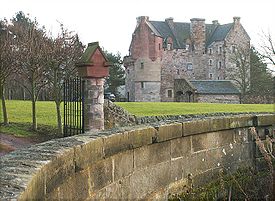
Dairsie
Encyclopedia

Fife
Fife is a council area and former county of Scotland. It is situated between the Firth of Tay and the Firth of Forth, with inland boundaries to Perth and Kinross and Clackmannanshire...
, Scotland
Scotland
Scotland is a country that is part of the United Kingdom. Occupying the northern third of the island of Great Britain, it shares a border with England to the south and is bounded by the North Sea to the east, the Atlantic Ocean to the north and west, and the North Channel and Irish Sea to the...
. It is 3 miles (4.8 km) south-southwest of Leuchars
Leuchars
Leuchars is a small town near the north-east coast of Fife in Scotland.The town is nearly to the north of the village of Guardbridge, which lies on the north bank of the River Eden where it widens to the Edenmouth estuary before joining the North Sea at St Andrews Bay. Leuchars is north-east of...
Junction, and 3 miles (4.8 km) east-northeast of Cupar
Cupar
Cupar is a town and former royal burgh in Fife, Scotland. The town is situated between Dundee and the New Town of Glenrothes.According to a recent population estimate , Cupar had a population around 8,980 making the town the ninth largest settlement in Fife.-History:The town is believed to have...
on the A91
A91 road
The A91 is a major road in Scotland, United Kingdom. It runs from St Andrews to Bannockburn, via Cupar. Along the way, the road runs adjacent to parts of the St. Andrews Old Course and Jubilee golf courses into Guardbridge. Past Guardbridge is Clayton Caravan Park. Further towards Cupar is the Eden...
Stirling
Stirling
Stirling is a city and former ancient burgh in Scotland, and is at the heart of the wider Stirling council area. The city is clustered around a large fortress and medieval old-town beside the River Forth...
to St Andrews
St Andrews
St Andrews is a university town and former royal burgh on the east coast of Fife in Scotland. The town is named after Saint Andrew the Apostle.St Andrews has a population of 16,680, making this the fifth largest settlement in Fife....
road. The village grew out of two smaller settlements (called Dairsiemuir and Osnaburgh), and developed principally around the industry of weaving
Weaving
Weaving is a method of fabric production in which two distinct sets of yarns or threads are interlaced at right angles to form a fabric or cloth. The other methods are knitting, lace making and felting. The longitudinal threads are called the warp and the lateral threads are the weft or filling...
. Since the late twentieth century it has become a dormitory settlement for nearby towns.
The village may have derived its name of Osnaburgh from weaving osnaburg
Osnaburg
Osnaburg was a coarse type of plain textile fabric, named for the city of Osnabrück . Originally made from flax yarns, it has been made from either flax, tow or jute yarns, sometimes flax or tow warp with mixed or jute weft, and often entirely of jute...
, a coarse linen or cotton, originally imported from Osnabrück
Osnabrück
Osnabrück is a city in Lower Saxony, Germany, some 80 km NNE of Dortmund, 45 km NE of Münster, and some 100 km due west of Hanover. It lies in a valley penned between the Wiehen Hills and the northern tip of the Teutoburg Forest...
in Germany.
Historic buildings
Dairsie BridgeDairsie Bridge
Dairsie Bridge is a 16th-century stone bridge, located south of Dairsie, in north-east Fife, Scotland. It carries a minor road across the River Eden, linking the parishes of Dairsie to the north and Kemback to the south...
, 1 miles (1.6 km) south of the village, dates from the early sixteenth century, although it has been modified since. Nearby Dairsie Castle
Dairsie Castle
Dairsie Castle is a restored tower house located south of Dairsie in north-east Fife, Scotland. The castle overlooks the River Eden.-History:...
(now restored) dates from the early seventeenth century, and was briefly the residence of John Spottiswoode
John Spottiswoode
John Spottiswoode was an Archbishop of St Andrews, Primate of All Scotland and historian of Scotland.-Life:...
(1565-1639), Archbishop of St Andrews
Archbishop of St Andrews
The Bishop of St. Andrews was the ecclesiastical head of the Diocese of St Andrews and then, as Archbishop of St Andrews , the Archdiocese of St Andrews.The name St Andrews is not the town or church's original name...
. King James VI stayed at Dairsie Castle following his escape from the Raid of Ruthven
Raid of Ruthven
The Raid of Ruthven was a political conspiracy in Scotland which took place on 22 August 1582. It was composed of several Presbyterian nobles, led by William Ruthven, 1st Earl of Gowrie, who abducted King James VI of Scotland. He was seized while staying at the castle of Ruthven , and kept under...
in June 1583. St Mary's Church
Dairsie Old Church
Dairsie Old Church, formerly St Mary's Church, is the former parish church of Dairsie, in north-east Fife, Scotland. It is located around south of Dairsie village. The present church was built in 1621, and is an unusual example of post-Reformation Gothic architecture in Scotland...
was built by Archbishop Spottiswoode in 1621. The church is some distance from the village and ceased to be used for worship in 1966. It is now in private hands, and the parish worshippers use the former St Leonard's Church in the village. The congregation is united with St John's Church in Cupar.

